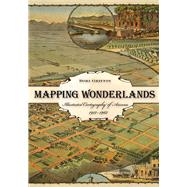Mapping Wonderlands

Mapping Wonderlands
- ISBN 13:
9780816509324
- ISBN 10:
0816509328
- Format: Hardcover
- Copyright: 05/02/2013
- Publisher: Univ of Arizona Pr
Rent
Sorry, this item is currently unavailable.
Note: Supplemental materials are not guaranteed with Rental or Used book purchases.
Extend or Purchase Your Rental at Any Time
Need to keep your rental past your due date? At any time before your due date you can extend or purchase your rental through your account.
Summary
Though tourism now plays a recognized role in historical research and regional studies, the study of popular touristic images remains sidelined by chronological histories and objective statistics. Further, Arizona remains underexplored as an early twentieth-century tourism destination when compared with nearby California and New Mexico. With the notable exception of the Grand Canyon, little has been written about tourism in the early days of Arizona's statehood. Mapping Wonderlands fills part of this gap in existing regional studies by looking at early popular pictorial maps of Arizona. These cartographic representations of the state utilize formal mapmaking conventions to create a place-based state history. They introduce illustrations, unique naming conventions, and written narratives to create carefully visualized landscapes that emphasize the touristic aspects of Arizona. Analyzing the visual culture of tourism in illuminating detail, this book documents how Arizona came to be identified as an appealing tourism destination. Providing a historically situated analysis, Dori Griffin draws on samples from a comprehensive collection of materials generated to promote tourism during Arizona's first half-century of statehood. She investigates the relationship between natural and constructed landscapes, visual culture, and narratives of place. Featuring sixty-six examples of these aesthetically appealing maps, the book details how such maps offered tourists and other users a cohesive and storied image of the state. Using historical documentation and rhetorical analysis, this book combines visual design and historical narrative to reveal how early-twentieth-century mapmakers and map users collaborated to imagine Arizona as a tourist's paradise. Though tourism now plays a recognized role in historical research and regional studies, the study of popular touristic images remains sidelined by chronological histories and objective statistics. Further, Arizona remains underexplored as an early twentieth-century tourism destination when compared with nearby California and New Mexico. With the notable exception of the Grand Canyon, little has been written about tourism in the early days of Arizona's statehood. Mapping Wonderlands fills part of this gap in existing regional studies by looking at early popular pictorial maps of Arizona. These cartographic representations of the state utilize formal mapmaking conventions to create a place-based state history. They introduce illustrations, unique naming conventions, and written narratives to create carefully visualized landscapes that emphasize the touristic aspects of Arizona. Analyzing the visual culture of tourism in illuminating detail, this book documents how Arizona came to be identified as an appealing tourism destination. Providing a historically situated analysis, Dori Griffin draws on samples from a comprehensive collection of materials generated to promote tourism during Arizona's first half-century of statehood. She investigates the relationship between natural and constructed landscapes, visual culture, and narratives of place. Featuring sixty-six examples of these aesthetically appealing maps, the book details how such maps offered tourists and other users a cohesive and storied image of the state. Using historical documentation and rhetorical analysis, this book combines visual design and historical narrative to reveal how early-twentieth-century mapmakers and map users collaborated to imagine Arizona as a tourist's paradise.






